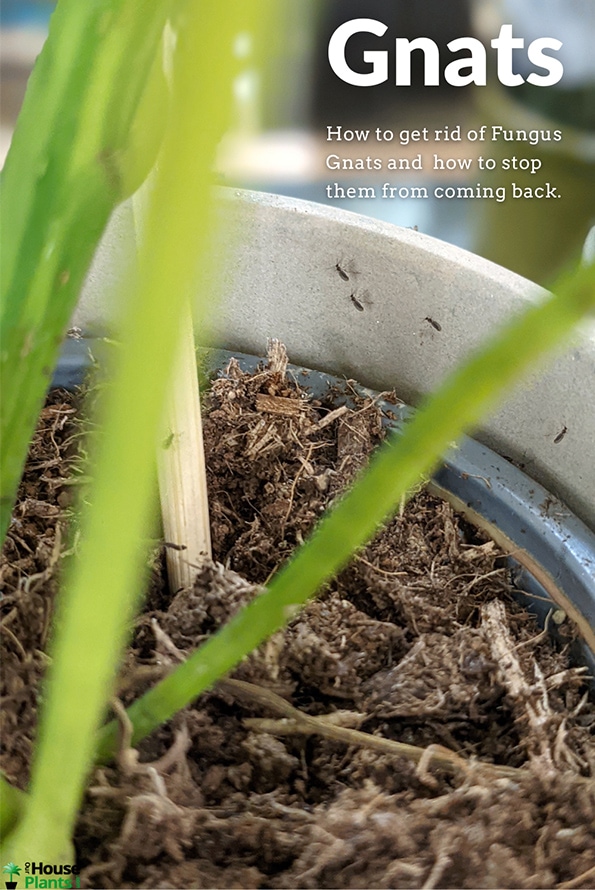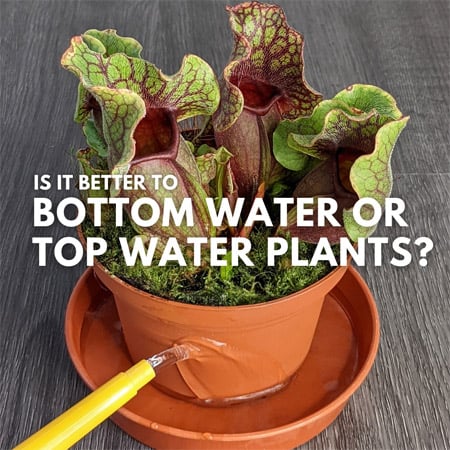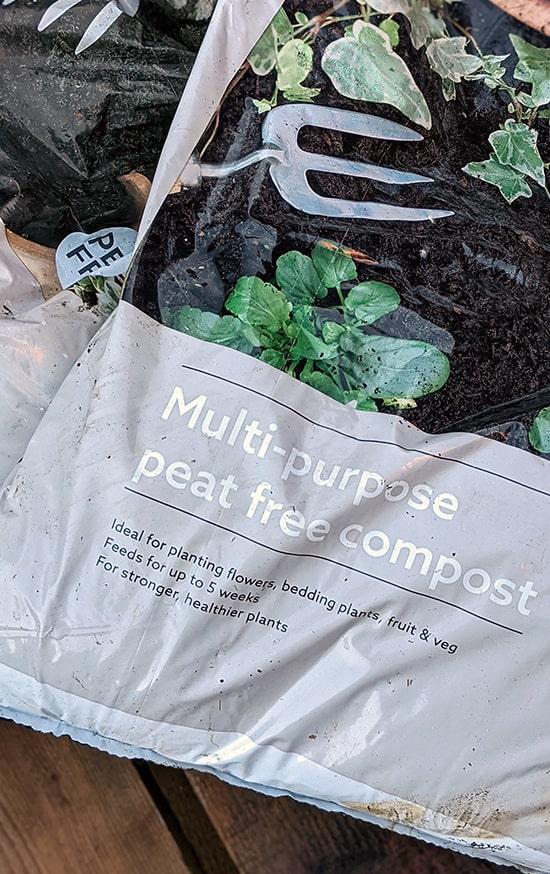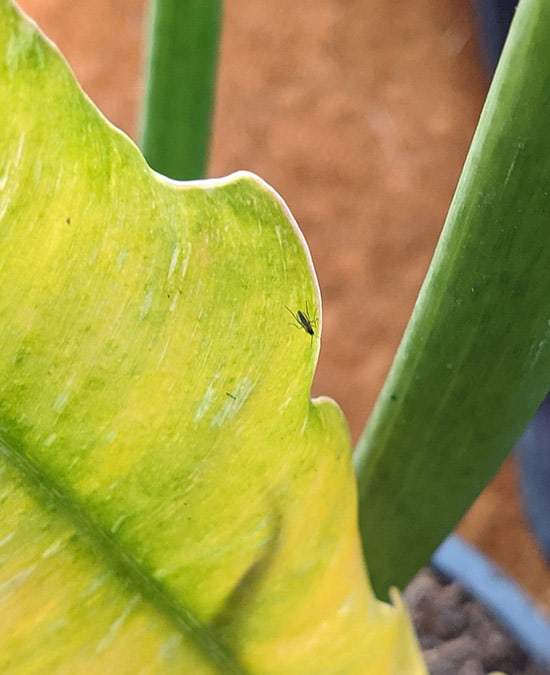Fungus Gnats are small flies that dart around your houseplants. They primarily live and reproduce in the top inch or so of your indoor plant's potting soil. As far as pests go, they don't usually do much damage to our plants.
But they're incredibly annoying.
Adult fungus gnats have poor eyesight and are attracted to light and the carbon dioxide in our breath. This means they can easily be enticed to leave the plant pot and explore. Their subtle buzzing and tendency to hover near faces can be particularly irritating.
Orfelia, Sciaridae and the Bradysia species can all create a Fungus Gnat infestation. They're attracted to damp soil and feed on the organic matter around plant roots.
They're rarely harmful to houseplants, even when you have a particularly bad or long lasting outbreak. Their true impact lies in their ability to become tiresome and gradually diminish your enjoyment of your houseplants.
So let's sort it out and learn how to get rid of them.

Hi, I'm Tom!
If you're like me and enjoy the challenge of growing houseplants and getting them to thrive, then Ourhouseplants can help. This website shares my knowledge and years of growing plants and provides (hopefully) helpful advice on properly caring for your indoor plant friends.
Understanding the Gnat Lifecycle begins by exploring their distinct appearances at each growth stage. Beginning as minute eggs, they transition into microscopic larvae before maturing into small, long-legged flies.
For such an annoying pest, they don't live very long. Their individual lifespan is quite brief – up to 30 days, with only about 7 spent as winged adults.
Stage 1
The female will search out a suitable home to lay up to 200 fungus gnat eggs. This will usually be in the top inch or two of the potting soil around our houseplants. She favors conditions that are moist and contains organic material, providing sustenance for the soon to hatch hungry larvae.
Stage 2
Around 5 days after laying the eggs will hatch into larvae. They're tiny insects and won't move far, simply growing bigger and eating the nearby material.
Stage 3
For two weeks or so, the larva will grow bigger. Then it pupates and prepares to assume its ultimate form, which takes another 5 days.
Stage 4
The pupa breaks open and the flying fungus gnat emerges. At this point, it becomes airborne. In their adult form they resemble Fruit flies but are actually pretty weak and slow fliers. Instead, they can often be seen running around surfaces or on top of the soil of your plants. When they're airborne, they lazily buzz around.
In this final stage they have just 7 days to find a mate and lay the next generation of eggs before perishing. And then the cycle starts again.
As the lifecycle breakdown illustrates, despite their short lives, Fungus Gnats undergo several distinct stages. Getting rid of them permanently, hinges on disrupting one or more of these vital lifecycle phases. Given that the insects are present at various growth stages simultaneously, achieving their complete removal may require up to 30 days.
Fortunately, you don't need to spend much time or money sorting them out. Here are five methods I've tried over the years that have worked either partly or entirely.
1
Fungus Gnat larvae are reliant on a constant moisture supply, rendering them vulnerable to dry soil. Meaning they struggle to survive in dry soil. I don't usually bottom water my houseplants, but bottom watering can be very effective in helping to reduce Gnat numbers when used for a few weeks.
Watering from the bottom, the roots of your plants will have access to moisture, but you only give a small amount. Water is pulled up into the growing medium by by capillary action. This keeps the top half of the growing medium dry.
The problem with this solution is that it doesn't deal with the eggs. Once laid, the eggs can stay dormant for several months until the conditions are right. As soon as you think your Gnat problem is gone, you resume your usual top watering, which triggers the eggs to start hatching and the problem returns.
2
Sticky traps will help tackle the flying adults. All they are is a small piece of paper or card with a sticky covering. The flies get caught on the sticky surface and can no longer fly around to mate or lay eggs.
A sticky trap will not stop the larva or eggs from progressing to the adult stage.
Any flying adults could also have the time to mate and lay eggs before getting caught in the traps. You only need one female to be successful and you could have another infestation heading your way.
But, the yellow sticky traps will help restore your sanity by drastically reducing the number of flies you see and hear buzzing around you. It can also reduce the risk of them making it to other houseplants in your collection. However, you must add one of the following three Solutions to stop them completely.
3
Soil Drenches can damage the eggs, larva and pupa stages. Applying Neem Oil or Hydrogen Peroxide on Fungus Gnats have all shown to be effective.
Although drenches are in theory non toxic and do little direct harm to the plant's roots, they can damage any beneficial bacteria or microorganisms living in the soil. This could weaken the plant in the long term or mean you have to repot your houseplant sooner than you might be planning to.
How do I carry out a Soil Drench?
Don't worry, it's pretty easy to do. Here is a step by step instruction for a Neem Oil drench.
With this in mind, a soil drench is a last resort option. Use one of the following two options first.
But if you can't, the drench can drastically reduce their numbers or help get rid of them completely.
4
All other methods on this list are generally passive ways to deal with Fungus Gnats. Beneficial nematodes on the other hand are a very active way to deal with large out of control infestations.
Nematodes are microscopic creatures, harmless to people and pets, but will hunt down and eat Fungus Gnats, providing you with powerful biological control. Most people will use Steinernema feltiae or a Predatory mite like Stratiolaelaps.
They will sustain themselves by eating the Gnat population, and after that diminishes the Nematodes will either move on or die out themselves. You can't easily see them and they don't negatively affect your houseplants.
Some will even go after multiple pests, like Thrips, so they can be very cost-effective if you have a lot going on, pest-wise. However, for small infestations, it might not be worthwhile, both in the expense and how you store them. So while they work and I do recommend them, I'd only consider them after you've given the next idea a go.
5
The final way to get control is using the hybrid biological and chemical approach by using Mosquito Dunks or Mosquito Bits. These contain Bacillus thurigiensis var. israelensis (BTi), an organic larvicide that is non-toxic to pets, fish, and people.
The BTi will persist in the soil for over a month, ensuring it can work on any larva that gets missed during your first application.
Usage is pretty straightforward. The first method you can use, is to grab a donut or a handful of "bits" and add them to your watering can to make a sort of "tea". Let the product soak in the water for at least 12 hours before you use it for the best results.
When it's ready, you water the infested plants. It's important to thoroughly saturate the top few inches of the potting medium with the solution, as this is the primary habitat of the larvae, so water all around the potting mix, not just in one area.
It's fast acting and people often report their Fungus Gnat numbers drop massively or completely within two days.
To be extra safe, you can reapply the liquid for the next couple of weekly waterings. In one study, this was shown to be the best way to give long lasting control.
Combine Approaches for best results.
If you combine the Mosquito Bits method with the Sticky Traps, you will help ensure no further eggs are laid by any adults that are still flying around.
The second approach is to break a donut apart or sprinkle a handful of bits on the soil surface. You soak the product on the surface every time you water your plant, and small amounts of the BTi are released into the soil.
This provides long last protection. It's not as immediate or as fast acting as making the "tea," but some people find it gives better results in the long term.
This is a permanent and effective solution that doesn't cost much or take up too much time. You get plenty of bits or donuts in a pack and they can be stored for a long time in case you get repeat problems later on. In my experience this is the best way to deal with Gnats.
There are many ideas out there that people have used to repel Gnats. Here are some I keep coming across but don't recommend, and I'll explain why.
How to avoid Fungus Gnats in indoor plants? You can't usually prevent Gnats completely, as some things are beyond your control. But two things really increase your chances of an infestation starting. Get a handle on the following two points, and you'll avoid having to deal with them on a regular basis.
Gnats need a food source; and as their name suggests, fungus is one of their favorites. This stuff will grow easily in damp low light conditions, it's not often visible to the human eye, but Gnats will feed on it happily.
This is why overwatering can be a real problem as it can provide good growing conditions for fungi to thrive in.
READ MORE - Is it better to bottom water or top water plants?
You can use the bottom watering technique, in fact, I encourage this when you have a Gnat problem happening right now. However, I'm not too fond of bottom watering in everyday settings for the reasons I explore in my post linked above.
Instead, the solution is to reset your watering skills and learn that constantly moist soil isn't essential for most houseplants. A little drying out of the top inch or so of the soil surface can be very beneficial to plant health and at the same time it deters Fungus Gnats.
This is a tricky one to solve. In my experience, 90% of my Fungus Gnat problems started with potting compost that I've brought from a store in a large bag.
Garden centers often sell large bags of damp potting soil or compost that can cause a fungus gnat problem in your home.
Big bags are often more cost-effective when brought in bulk in large volume like this. But to save costs, the shop will likely store them outside, exposed to the rain, and probably had them in warehouses for months (or longer) - plenty of time for Gnats to have found them and laid eggs.
The potting mix normally contains lots of organic materials too, so it's an ideal breeding ground for Fungus Gnats.
You use the potting mix and a few weeks later you have hundreds of Gnats flying around. It's likely contaminated and might be worth using what's left on outdoor plants instead.
If you'd rather not do this, then you need to let the bag fully dry out and store it somewhere where this can happen. Keep it dry for several months.
Fungus Gnats are prevalent and common pests. While they typically do not inflict major damage on houseplants, their resemblance to mosquitoes or fruit flies makes them highly irritating to most people.
They're easy to eliminate if you use several tools to disrupt their life cycle. If you only use one method or only do it half-heartedly, you're likely to have them in your homes for months or even longer.
Fungus Gnat adults are pretty poor fliers, and instead prefer to use their long legs to run over indoor plants, plant pots or surfaces in your home.
Gnats typically thrive in wet soil, so can be encouraged by poor watering skills, or by bringing back infested potting soil or plants from stores. If untreated they can create homes in your other plants and before long they can grow to large numbers.
The most effective way to get rid of them is to use Sticky Traps to capture the adults and Mosquito Bits. These "bits" contain bacillus thuringiensis, a bacteria that is highly effective against the larval stage of certain flying insects. One or two applications could be all you need to get rid of them.
Fungus Gnats are common, but you can get rid of them fairly fast. The five methods I've listed have worked for me over the years, but if you have a secret you want to share, let us know in the comments.



